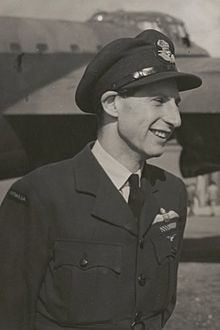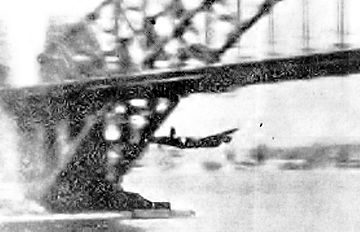Peter Isaacson facts for kids
Quick facts for kids
Peter Stuart Isaacson
|
|
|---|---|

Flight Lieutenant Isaacson with Lancaster Q-for-Queenie, 1943
|
|
| Born | 31 July 1920 London |
| Died | 7 April 2017 (aged 96) Melbourne |
| Allegiance | Australia |
| Service/ |
Royal Australian Air Force |
| Years of service | 1940–46 (RAAF) 1946–69 (RAAF Reserve) |
| Rank | Wing Commander |
| Unit | RAF Bomber Command |
| Battles/wars | World War II |
| Awards |
|
| Other work | Publisher |
Peter Stuart Isaacson (born July 31, 1920 – died April 7, 2017) was an Australian publisher and a brave military pilot. He owned Peter Isaacson Publications, which printed many business magazines and local newspapers in Melbourne. These included the Southern Cross and the Sunday Observer.
During World War II, Peter Isaacson was a pilot in the Royal Australian Air Force (RAAF). He flew for RAF Bomber Command and earned several important awards for his courage. These included the Distinguished Flying Cross, the Air Force Cross, and the Distinguished Flying Medal.
Isaacson grew up in Melbourne and started working at a newspaper when he was sixteen. He joined the RAAF in 1940. After his time in Bomber Command, he became famous in Australia. He toured the country in his Avro 683 Lancaster bomber, nicknamed Q-for-Queenie. He did this to help sell "war loans," which were like special bonds to help fund the war. A very famous moment was when he flew his plane under the Sydney Harbour Bridge in 1943!
After the war, he joined the RAAF Reserve. He retired in 1969 as a Wing Commander. He also helped manage the Victorian Shrine of Remembrance for many years. In 1991, he received the Order of Australia award for his work in publishing and helping the community.
Early Life and Family
Peter Isaacson was born in London on July 31, 1920. His father was Australian, and his mother was Austrian. When Peter was six years old, his family moved to Australia. He grew up in Melbourne and went to Brighton Grammar School.
At sixteen, he started working as a messenger boy for The Age newspaper. His mother, Caroline, worked there too, editing the women's features. Peter's whole family helped during World War II. His father, Arnold, who fought in World War I, joined the Volunteer Defence Corps. His mother became a Public Relations Officer for the Australian Women's Army Service (AWAS). His sister Joan became a photographer for the AWAS.
World War II Heroics
On December 8, 1940, when he was nineteen, Peter Isaacson joined the Royal Australian Air Force (RAAF). He trained in Australia and Canada. Then, he was sent to the United Kingdom. He joined No. 460 Squadron RAAF in Yorkshire as a Sergeant Pilot.
His squadron flew Vickers Wellington bombers. They were part of RAF Bomber Command's plan to attack Germany. The squadron started flying missions in March 1942. They took part in huge raids with 1,000 bombers against cities like Cologne, Essen, and Bremen. In October, they started flying the larger Avro 683 Lancaster heavy bombers.
Peter Isaacson received the Distinguished Flying Medal on November 6, 1942. This was for his "many successful night attacks on the enemy." The next month, his Lancaster plane was damaged by a German Junkers Ju 88 night fighter after a raid on Munich.
He later became a Pilot Officer and joined No. 156 Squadron RAF. This squadron was part of the Pathfinder Force, which led bombing raids. He earned the Distinguished Flying Cross on March 30, 1943, for his brave actions during a raid on Berlin.
Peter Isaacson completed forty-five dangerous missions with Bomber Command. During the war, it was very dangerous, and many pilots didn't survive their missions. In May 1943, he was promoted to acting Flight Lieutenant. He was chosen to fly his Lancaster, Q-for-Queenie, on a special flight. He flew it from England to Australia across the Pacific Ocean. Then, he flew non-stop from Melbourne to New Zealand and back.
He received the Air Force Cross on August 27, 1943, for this amazing flight. The award noted it was the first time an aircraft had flown to Australia by that route. Also, the direct flights between Melbourne and New Zealand were the first of their kind.
The Lancaster was brought to Australia to be a model for building more planes there. But this never happened. Instead, it was used for special flights to encourage people to buy war bonds. These bonds helped pay for the war. On October 22, 1943, Peter Isaacson did something very daring. He flew Q-for-Queenie under the Sydney Harbour Bridge. This was against the rules! The Lancaster is still the largest aircraft to have flown under the bridge. He didn't tell his crew what he was going to do. When asked why, he simply said, "Because it was there." However, it was also reported that he did it to help promote the war loan effort.
In December 1943, after his tour with Q-for-Queenie, he became an instructor. He then went on another tour in the Lancaster starting in March 1944.
After the War: Publishing and Community Work
After the war, Peter Isaacson tried to become a politician. He ran for the Liberal party in the 1945 Victorian state election but was not elected. His military service ended on February 21, 1946. He then joined the RAAF Reserve.
He was in charge of the Victorian Squadron of the Air Training Corps from 1950. From 1961, he led No. 21 (City of Melbourne) Squadron. He retired in 1969 as a Wing Commander. He also served as an honorary helper to Queen Elizabeth II from 1963 to 1965.
After working as an aviation writer for The Argus newspaper, Peter Isaacson started his own newspaper, the Advertiser, in 1947. He also started Peter Isaacson Publications that same year. The Advertiser grew and became the Southern Cross. Peter Isaacson edited and published this paper, along with the Sunday Observer and many business magazines.
In 1986, his company took over the Asher Joel Media Group. In 1993, the Southern Cross was bought by APN News & Media. Peter Isaacson became a director for APN until 1998. He also led TW Media from 1997 to 2005.
Peter Isaacson married Anne McIntyre in Melbourne on December 21, 1950. They had known each other since they were teenagers. Their wedding was delayed because Anne had been struggling with polio for five years. Peter carried his future wife to the registry office on their wedding day. They had two sons.
On June 10, 1991, Peter Isaacson was awarded the Order of Australia. This was for his important work in the print media and for his community service. In 2012, he published a book called As I Remember Them. It was a collection of speeches he had given about his friends and colleagues. In May 2012, he was one of thirty-two veterans chosen to attend the dedication of the RAF Bomber Command Memorial in London.
Peter Isaacson was a Life Governor of the Victorian Shrine of Remembrance. He had also been a Trustee from 1956 to 2000 and Chairman from 1983 to 2000. He and his wife lived in Toorak, a suburb of Melbourne. Peter Isaacson passed away on April 7, 2017, in Melbourne. He was 96 years old. His wife Anne had passed away the year before. He was survived by his two sons.


